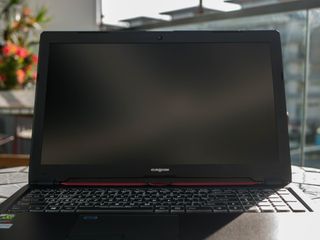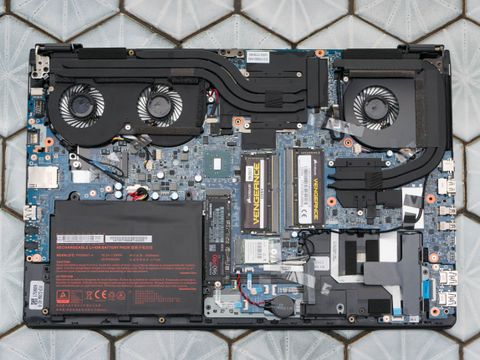Early Verdict
The Eurocom Q5 is a solid contender in the thin-and-light gaming laptop market, thanks to its GTX 1070 with Max-Q Design. However, prices for several components drive up the price unreasonably. We recommend upgrading memory and storage separately.
Pros
- +
Solid build quality
- +
Good performance
- +
Well-placed speakers
- +
Comfortable keyboard with backlight customization
- +
Accurate touchpad, Fingerprint sensor
- +
Fast SSD
Cons
- -
Extremely expensive for a GTX 1070 laptop
- -
Display exhibits poor contrast, is under-saturated, and has noticeable grayscale and color inaccuracies
Why you can trust Tom's Hardware
Introduction & Product Tour
Nvidia first revealed Max-Q back in May, teasing 85-90% GPU efficiency in thinner and lighter laptops. The first such laptop we reviewed was the Asus ROG Zephyrus, which featured an Nvidia GeForce GTX 1080 with Max-Q design, and it delivered on all fronts. We’ve been itching to test another Max-Q laptop ever since.
Today we’ll be looking at the Eurocom Q5, a 0.74” gaming laptop featuring a GTX 1070 with Max-Q design.
Specifications
Packaging



The Eurocom Q5 is based off the Clevo P957HP6, so you can expect Clevo’s generic brown “Notebook Computer” packaging. There’s a white plastic handle at the top of the box for easy carrying.


Inside, you’ll find the Q5 wrapped in plastic and three blocks of protective closed-cell foam. Adjacent to the foam blocks, you’ll find a box containing the Q5’s 180W adapter and an AC power cord. That’s it. No extra booklets or manuals. Just the laptop and its power accessories. The Q5’s manual can be found on Eurocom’s website.
The Q5’s packaging is as generic as you can get. This isn’t a negative, per se. However, competing Clevo resellers like Origin PC trek the extra mile by using their own branded packaging and extras (like posters). Our review of the Origin PC EON17-SLX illustrates the impressive unboxing experience.
Exterior








Luckily, the monotony ends with the packaging. When we finally got our hands on the Q5, we couldn’t help but feel astonished. The Q5 features an elegant black titanium-aluminum alloy construction that’s light yet sturdy. The lid has tastefully placed angular accents running from the hinge to the top of the lid. There’s a decorative plastic strip spanning between where the lid accents meet the top edge of the lid, complementing the Q5’s aggressive aesthetic. Perhaps most impressive is the lid’s lighting effects. In the very middle, there’s a translucent red plastic insignia, and there are two perforated strips located next to the angled accents. When the system is powered, the insignia and perforations emit a red light.
The interior area surrounding the input devices is also constructed out of titanium-aluminum alloy, which is pleasant to the touch but attracts fingerprints and smudges rather easily. Fortunately, the surface is easy to clean, at least compared to brushed-aluminum and rubberized plastic, which competing manufacturers tend to implement.







On the bottom left, beneath the keyboard, there are logo stickers highlighting a few of the Q5’s features, while the bottom right has a painted SoundBlasterX logo. At the very top of the interior surface, you’ll find three red accents, adding much needed color to the almost entirely black surface. The middle red accent acts as the Q5’s power button, and it has a power logo in the dead center. When the system is powered, a white LED turns on beneath the power button.


There are perforations dotted in and around the two red accents surrounding the power button; these perforations act as the Q5’s speakers, and are placed in the best possible position for audio clarity. The speakers can reach maximum volume without experiencing much distortion. Hopefully, laptop manufacturers will notice this and implement top-facing speakers in future models.




The Q5’s 15.6” display has a relatively standard bezel as far as gaming laptops go. Unlike the rest of the chassis, the bezels are constructed out of plastic, but this area isn’t as critical. The side bezels are 0.6875”, while the top bezel measures 0.875”. The bottom bezel is the longest, measuring 0.9375”. There are two small rubber feet on the side bezels and three long rubber feet on the top and bottom bezels. These separate the display from the interior surface when the lid is closed. The top bezel houses the 2.0 megapixel Full HD (1920x1080) webcam. Finally, Eurocom’s logo is printed on the bottom bezel in white.



The Q5’s entire chassis is almost entirely constructed out of titanium-aluminum alloy, so the edges are merely continuations of the lid and interior surface, wrapped around into shape. The front edge is plain, and only contains LED indicators for power/connectivity, charging, disk usage, and airplane mode. The Q5 is 0.74” thin, so the RJ-45 LAN port on the right edge has a small clamp that only opens when you plug in an Ethernet cable. Meanwhile, the left edge features ventilation for the Q5’s CPU. Finally, the rear edge is where things get interesting. You’ll find a red accent layer spanning nearly the entire length of the rear exhaust, giving some life to the mostly black color scheme. The exhausts vents aren’t perfectly symmetrical; right side vents feature fewer cutouts, because they only have to accommodate the CPU, whereas the left side vents are fully exposed for the Max-Q GPU.






The bottom panel looks by far the most aggressive. It’s littered with air intake cutouts, which occupy nearly half of the panel’s surface area. In between the intake cutouts, there is an angled accent spanning the length of the panel. Despite all of the cutouts, the metal construction remains robust and doesn’t fall victim to flexing. The bottom panel has three rubber feet to keep the Q5 stable; there are two small feet near the front corners and one large foot near the rear edge. The rear foot is basically one large strip of rubber, and only the far left and right sides of the foot make contact with your desk. Still, the large rubber foot is impressive to look at, and even more pleasing to feel.



The Q5’s hinges are connected to the display’s bezels, so they’re constructed out of plastic. If you look closely enough, you’ll find that the hinges feature a knurled design, perhaps to set the plastic construction apart from the rest of the metal build. The hinges are smooth and offer a fairly standard 135° of motion, which is unfortunate considering many thin and light laptops can extend at least 180°. Still, the Q5 is a gaming laptop first and foremost, so this isn’t a major issue.


The Eurocom Q5 has quite a few I/O ports for a thin and light laptop. On the left, you’ll find the DC power-in, an HDMI port, two mini DisplayPorts, two USB 3.1 Type-C ports, and two USB 3.0 ports. The right I/O features a microphone jack, a combination headphone/SPDIF jack, two card readers, the RJ-45 LAN port, and a Kensington lock.
Display

The Q5’s display is a 15.6” Full HD (1920x1080) TN display with a 5ms response time and a 120Hz refresh rate. Eurocom also offers 60Hz IPS models in either FHD or Ultra HD (3840x2160). Unfortunately, there are no models with G-Sync.
Additional displays can be connected via HDMI 2.0 or the two DisplayPorts.
Input Devices


The Q5 features the same full-length keyboard you’ll find on all Clevo models. The keys are well spaced and feature a satisfying bumpy actuation, making for a comfortable typing experience. The keys have a translucent white font that allows the backlighting to peer through keycaps without excessive backlight bleed. The WASD keys feature a white border around the font.
The function row has a number of predetermined functions: F1 toggles touchpad functionality; F2 switches between displays; F3, F5, and F6 adjust audio; F7 opens the Project menu; F8 and F9 adjust display brightness; F10 toggles the webcam; F11 toggles Airplane mode; F12 puts the Q5 to sleep. Additionally, you can open the ComboKeys software by pressing “Fn + /” and adjust backlight levels with “Fn and *,” “Fn and -,” and “Fn and +.”


The touchpad is incredibly accurate and comfortable to use. Its surface is distinctively grainier than the rest of the titanium-aluminum construction, which is great because you won’t experience much surface drag from oil buildup. The left and right buttons are separated from the rest of the touchpad, so you won’t experience uneven touchpad depth, which tends to plague gaming laptops. The left and right buttons have a satisfying bumpy feedback. On the top left of the touchpad, you’ll find a fingerprint sensor, which can be used to log in to your Windows profile. The sensor works almost immediately, which will save you a few seconds when signing in.
Interior






The bottom panel is secured to the chassis with 11 screws. Once those are removed, you can easily pop off the panel from the rear edge, giving you access to the interchangeable components. On the far right, you'll find a SATA slot, which you can slip a HDD into. Near the front edge, you’ll find the Q5’s 60 Wh battery. Right next to it is an M.2 2280 slot. A separate M.2 2242 slot is located just above the battery, below the GPU exhaust fans. Next to the M.2 2280 slot, you’ll find the Killer Wireless-AC 1535, which handles wireless connectivity. Above that rests two DDR4 memory slots.




The Q5’s cooling solution is split into two portions. On the right is the CPU heat sink, which has two heat pipes leading to the exhaust fan on the top right. The GPU’s cooling spans nearly the entire length of the Q5, with the GPU heat sink in the middle and three heat pipes drawing heat towards two exhaust fans on the left side of the Q5. Normally, the cooling solution is combined, with heat pipes being shared between the CPU and GPU. We’ll see whether the separated pipes produce better thermal conditions.
Software
Pressing “Fn + /” will launch ComboKeys, which is pre-loaded on most Clevo systems. From here, you can create macros, track statistics, and adjust backlight settings. The keyboard is split into three sections: left, middle, and right. The lights can be adjusted to any color in the RGB spectrum. Additionally, there are special settings, such as breathing, color cycling, and a left-to-right wave effect.
MORE: Best Gaming Laptops
MORE: Gaming Laptop Previews
MORE: All Laptop Content
-
AgentLozen Enjoyed the review. "... gripping ..." "... powerful."Reply
That Max Q technology makes me a little uncomfortable. It's difficult for me to accept that these otherwise hot video cards are being squeezed into a super tiny form factor. I know its supposed to work out despite what conventional wisdom suggests but if I NEEDED a GTX 1070 laptop, I'd rather it just be bulkier with better cooling.
It's a shame about the screen though. 120Hz is cool but I would like it to be better balanced with image quality. There are good looking TN panel monitors out there. For example, my Dell S2417DG looks good after I calibrated it. I guess Eurocom's TN screen isn't one of those decent ones. I wonder if the IPS option fairs any better. -
Lutfij Nice review but I'm a little worried about the price. Did you contact Eurocom and inform them about the absurdity in their pricing dept?Reply -
almostdecent It is worth mentioning that all Eurocom machines can be configured to taste, so the poor TN display is not an obligatory part of the laptop. I have a Eurocom laptop with a Sharp 4k display that has excellent image quality, with 100% sRGB reproduction and 76% Adobe RGB (according to Spyder calibration)Reply
